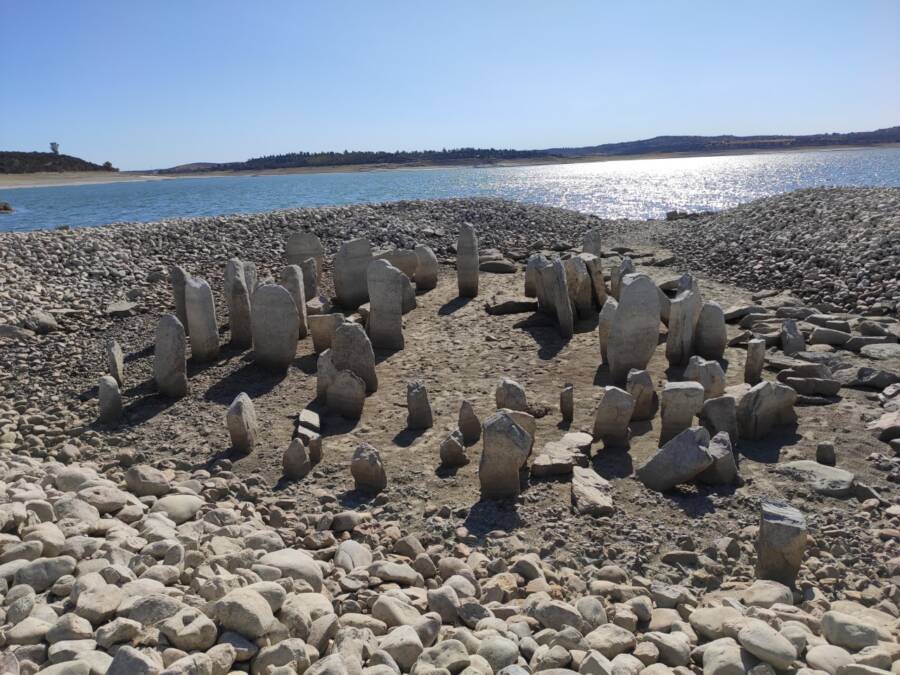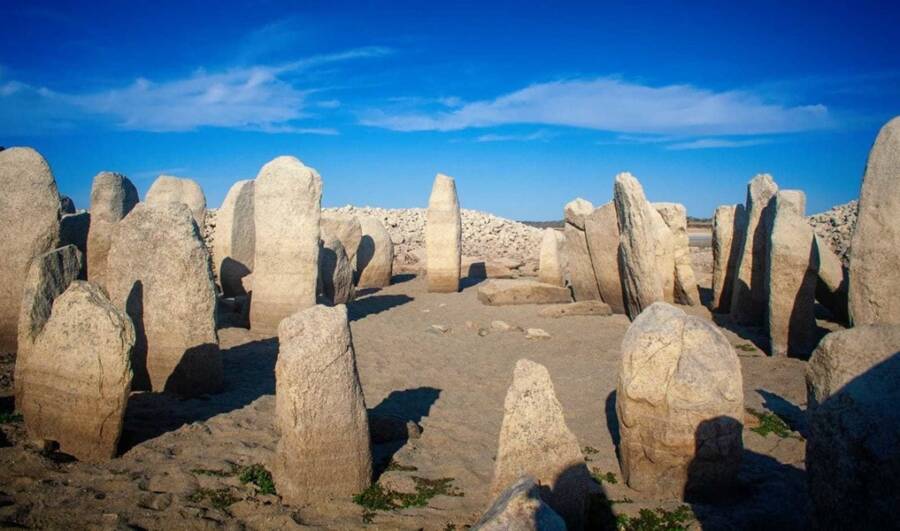Nice to see. It is far from robust in the scale of Stonehenge, but also was clearly structural which is not so obvious with Stonehenge.
In fact the clear structural aspect strongly supports the idea that Stonehenge was also structural. Then consider Golbeki Tepe in which shaped upright stones were put in place as a clearly dominant feature. This is a tradition that could easily be transmitted all over Eurasia. Of course, we are arguing here is that such a tradition lived from 9000 BC to around 2500 BC.
Yet this is presently defined as the pre Bronze Age era. Yet all forms of agriculture were also underway and this meant an intensification of populations. We do not know this directly, but it also makes sense that there were knowledge centers as well. Not many and truly distant but real enough.
Then throw in the speculative prospect of guidance through long lived leaders reflected by Noah and his successors who easily covered around four or more thousand years. This tradition projects far greater cultural continuity that otherwise plausible as some form of written language emerged as well.
Consider that little of this happened in most other regions during this time window and failed to emerge before direct contact inspired it all..
Drought Uncovers ‘Spanish Stonehenge’ Hidden Underwater For Decades
By Natasha Ishak
Published September 17, 2019
Updated September 18, 2019
"I had seen parts of it peeking out from the water before, but this is the first time I've seen it in full."
https://allthatsinteresting.com/dolmen-de-guadalperal
Ruben Ortega Martin/Raices de PeraledaThe Dolmen de Guadalperal, also known as the “Spanish Stonehenge,” has been completely exposed for the first time in 50 years following the drought.
Severe changes in weather, particularly across Europe, have been a curse for farmers whose crops are suffering and who are losing millions of euros because of it. But for archaeologists, these severe changes sometimes help them gain access to relics that were previously out of reach.
Take Spain’s 7,000-year-old Dolmen de Guadalperal, a megalithic monument made up of 144 standing stones — some up to six feet tall — arranged in a circular open space. Located in the province of Cáceres, this previously-underwater monument has now been completely exposed following the harsh drought that has hit the area.
Often referred to as the “Spanish Stonehenge” thanks to certain similarities with the original in England, this structure has now appeared for the first time in 50 years.
“I had seen parts of it peeking out from the water before, but this is the first time I’ve seen it in full,” said Angel Castaño, president of the local cultural association, as quoted in Atlas Obscura.
“It’s spectacular because you can appreciate the entire complex for the first time in decades.”

As a resident of Peraleda de la Mata, a village just a couple miles from the dolmen’s location, Castaño has been familiar with the ancient structure all his life. Yet, this is the first time he has been able to truly appreciate its magnificence.
The Dolmen de Guadalperal was not always submerged underwater. The area around Cáceres was still dry when the monument was first uncovered by German archaeologist Hugo Obermaier, who led an excavation of the site in the mid-1920s. It wasn’t until four decades later that Obermaier’s paper about the ancient structure was finally published.
The archaeological site, for the most part, remained undisturbed until the Spanish government wanted to build a dam and reservoir right around it. Construction of the Valdecañas Reservoir flooded the area and submerged the historical stones in water in 1963.

1080 Wildlife ProductionsThe Dolmen de Guadalperal from above. Archaeologists hope to get the ancient structure moved before it is flooded again.
If water were to drown an entire archaeological site today, there would most certainly be an immediate backlash from historians and researchers, which is currently happening with the soon-to-be flooded historical site of Hasankeyf. But back then, the dolmen’s flooding was simply accepted.
Primitiva Bueno Ramirez, a specialist in prehistory at the University of Alcalá, explained that the importance of archaeological studies back then weren’t as appreciated as they are now, and there was no standard practice for creating environmental reports before such a massive project was greenlit.
“You couldn’t believe how many authentic archaeological and historic gems are submerged under Spain’s man-made lakes,” Ramirez said.
The re-emergence of the Dolmen de Guadalperal has no doubt excited archaeologists, who believe that the stones in the structure were transported from three miles away on the banks of the Tagus River, the longest waterway in the Iberian Peninsula, sometime in the fifth millennium BC. It was meant as a burial place and a temple to worship the sun.
Scientists believe that, though its current shape appears to be that of an open-air, unfinished circle, the monument was once entirely enclosed, complete with a roof on top.
According to Ramirez, people would have entered through a narrow hallway adorned with engravings and other decorations to access the original structure. The hallway would lead into a more spacious main chamber that was 16 feet across, where the dead were likely kept.
By Natasha Ishak
Published September 17, 2019
Updated September 18, 2019
"I had seen parts of it peeking out from the water before, but this is the first time I've seen it in full."
https://allthatsinteresting.com/dolmen-de-guadalperal
Ruben Ortega Martin/Raices de PeraledaThe Dolmen de Guadalperal, also known as the “Spanish Stonehenge,” has been completely exposed for the first time in 50 years following the drought.
Severe changes in weather, particularly across Europe, have been a curse for farmers whose crops are suffering and who are losing millions of euros because of it. But for archaeologists, these severe changes sometimes help them gain access to relics that were previously out of reach.
Take Spain’s 7,000-year-old Dolmen de Guadalperal, a megalithic monument made up of 144 standing stones — some up to six feet tall — arranged in a circular open space. Located in the province of Cáceres, this previously-underwater monument has now been completely exposed following the harsh drought that has hit the area.
Often referred to as the “Spanish Stonehenge” thanks to certain similarities with the original in England, this structure has now appeared for the first time in 50 years.
“I had seen parts of it peeking out from the water before, but this is the first time I’ve seen it in full,” said Angel Castaño, president of the local cultural association, as quoted in Atlas Obscura.
“It’s spectacular because you can appreciate the entire complex for the first time in decades.”

As a resident of Peraleda de la Mata, a village just a couple miles from the dolmen’s location, Castaño has been familiar with the ancient structure all his life. Yet, this is the first time he has been able to truly appreciate its magnificence.
The Dolmen de Guadalperal was not always submerged underwater. The area around Cáceres was still dry when the monument was first uncovered by German archaeologist Hugo Obermaier, who led an excavation of the site in the mid-1920s. It wasn’t until four decades later that Obermaier’s paper about the ancient structure was finally published.
The archaeological site, for the most part, remained undisturbed until the Spanish government wanted to build a dam and reservoir right around it. Construction of the Valdecañas Reservoir flooded the area and submerged the historical stones in water in 1963.

1080 Wildlife ProductionsThe Dolmen de Guadalperal from above. Archaeologists hope to get the ancient structure moved before it is flooded again.
If water were to drown an entire archaeological site today, there would most certainly be an immediate backlash from historians and researchers, which is currently happening with the soon-to-be flooded historical site of Hasankeyf. But back then, the dolmen’s flooding was simply accepted.
Primitiva Bueno Ramirez, a specialist in prehistory at the University of Alcalá, explained that the importance of archaeological studies back then weren’t as appreciated as they are now, and there was no standard practice for creating environmental reports before such a massive project was greenlit.
“You couldn’t believe how many authentic archaeological and historic gems are submerged under Spain’s man-made lakes,” Ramirez said.
The re-emergence of the Dolmen de Guadalperal has no doubt excited archaeologists, who believe that the stones in the structure were transported from three miles away on the banks of the Tagus River, the longest waterway in the Iberian Peninsula, sometime in the fifth millennium BC. It was meant as a burial place and a temple to worship the sun.
Scientists believe that, though its current shape appears to be that of an open-air, unfinished circle, the monument was once entirely enclosed, complete with a roof on top.
According to Ramirez, people would have entered through a narrow hallway adorned with engravings and other decorations to access the original structure. The hallway would lead into a more spacious main chamber that was 16 feet across, where the dead were likely kept.

No comments:
Post a Comment